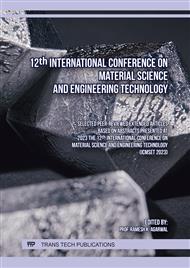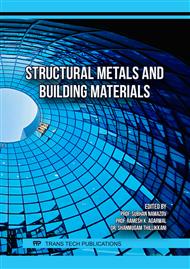[1]
C.C.A.G. Edward Estid Ruiz Galeano, "Modelacion por el método de elementos finitos (MEF), mediante el software ANSYS del elemnto de olaca.," Univ. Dist. Fr. José caldas, p.19, 2019.
Google Scholar
[2]
S. Botello, "Ejemplos de Aplicación de los Métodos Numéricos a Problemas de Ingeniería," Cent. Investig. en Matemáticas A.C., p.19, 2011, [Online]. Available: https://www.cs.buap.mx/~sandoval/MetodosNumericos/botello_rionda.pdf.
Google Scholar
[3]
J.A. Duarte, H. O. Reinert, F.D. Gattelli, A.E. Ares, and O. Möller, "Simulación Numerica De Ensayos Mecánicos En Mampuestos Regionales De Misiones, Argentina," vol. XXXIII, p.23–26, 2014.
Google Scholar
[4]
H.O. Reinert, "Modeling mixed-mode dynamic crack propagation using finite elements: Theory and applications," vol. XXXII, p.19–22, 2013.
Google Scholar
[5]
y I.A.R. Swenson D.V., "Modeling mixed-mode dynamic crack propagation using finite elements: Theory and applications," Comput. Mech., vol. 3, p.381–397, 1988.
DOI: 10.1007/BF00301139
Google Scholar
[6]
A. Zúñiga, "Ciencia e ingeniería de nuevos materiales en la fabricación mejorados tecnologicamente," Universidad Politécnica de Madrid, 2018.
DOI: 10.20868/upm.thesis.52643
Google Scholar
[7]
B. Zúñiga-Torres, F. Hernández-Olivares, F. Fernández-Martínez, A. Zúñiga-Suárez, and B. N. Ruiz, "Influence of carbon nanotubes on traditional material," Mater. Sci. Forum, vol. 1023 MSF, p.147–154, 2021.
DOI: 10.4028/www.scientific.net/MSF.1023.147
Google Scholar
[8]
B. Zúñiga-Torres et al., "Innovative materials for sustainable construction," Mater. Sci. Forum, vol. 1023 MSF, p.155–162, 2021.
DOI: 10.4028/www.scientific.net/MSF.1023.155
Google Scholar
[9]
J. J. Del Coz Díaz, P. J. García Nieto, F. P. Álvarez Rabanal, and A. Lozano Martínez-Luengas, "Design and shape optimization of a new type of hollow concrete masonry block using the finite element method," Eng. Struct., vol. 33, no. 1, p.1–9, 2011.
DOI: 10.1016/j.engstruct.2010.09.012
Google Scholar
[10]
P. R. Prakash, M. Azenha, J. M. Pereira, and P. B. Lourenço, "Finite element based micro modelling of masonry walls subjected to fire exposure: Framework validation and structural implications," Eng. Struct., vol. 213, p.110545, Jun. 2020.
DOI: 10.1016/J.ENGSTRUCT.2020.110545
Google Scholar
[11]
A. Kumar and K. Pallav, "Static and dynamic analysis of unreinforced masonry wall using finite element modeling in senate hall building ," 2018.
DOI: 10.21203/rs.3.rs-3248596/v1
Google Scholar
[12]
D. Corbella, F. Fernandez, F. Hernandez, and P. Armisen, "New designs of the ceramic bricks of horizontal hexagonal hollow," Jt. Conf. Mech. Des. Eng. Adv. Manuf., vol. 4, p.7, 2014, [Online]. Available: http://oa.upm.es/30730/.
Google Scholar
[13]
C. Maza, "Ladrillos de suelo-cemento con adición de corrector orgánico como alternativa de material para la construcción," p.99, 2019.
DOI: 10.3989/ic.1962.v15.i142.4849
Google Scholar
[14]
J. Salkind, "El papel y la importancia de la investigación," no. October, p.226765, 1998.
Google Scholar
[15]
N. INEN 292, "Ladrillo cerámicos muestreo," Inst. Ecuatoriano Norm., p.1–6, 1977.
Google Scholar
[16]
N. INEN 297, "Ladrillos cerámicos. Requisitos," Inst. Ecuatoriano Norm., vol. 297, p.7, 1978.
Google Scholar



